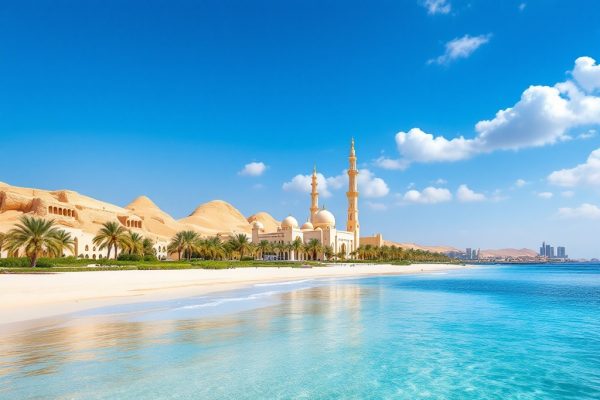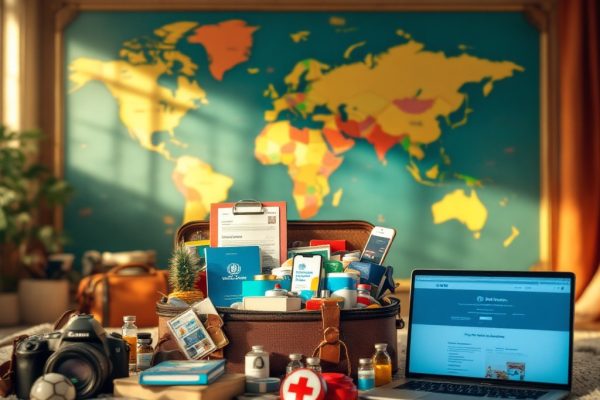The Safest Countries to Travel to
Dreaming of a safe and unforgettable trip in 2025? Discover the world’s safest countries, led by Iceland and Australia, renowned for low crime rates and stunning landscapes. Explore top destinations like New Zealand, Germany, and Canada, each offering unique experiences with peace of mind. Learn crucial safety tips and resources, from understanding travel advisories to prioritizing transportation and healthcare. Plan your perfect adventure now and travel with confidence!
Important information

- Iceland ranks as the safest country to travel to in 2025, followed by Australia, Canada, Ireland, and Switzerland.
- Key safety factors include low crime rates, quality healthcare, reliable transportation, and positive traveler experiences.
- Travelers should research their destination, understand local laws and customs, and check travel advisories before and during their trip.
- Sharing your itinerary with someone you trust and obtaining comprehensive travel insurance are recommended for a safe trip.
- Being aware of your surroundings, securing valuables, and avoiding risky areas are crucial for personal safety while traveling.
The Safest Countries to Travel to in 2025
Iceland leads as the safest travel destination for 2025, followed by Australia. Other secure options include New Zealand, Germany, Norway, Japan, and Denmark, along with Portugal, Spain, the UK, the Netherlands, and Sweden. These rankings are based on factors such as crime rates, healthcare quality, and overall traveler experiences.
Iceland’s remarkably low crime rate, peaceful ambiance, and minimal traffic contribute to its top ranking. Australia’s remote location and low crime also ensure its safety.
Canada, Ireland, and Switzerland complete the top five safest countries.
Canada consistently earns high marks for safety, securing its third-place position. Ireland offers a welcoming atmosphere for visitors, placing it fourth. Switzerland’s well-maintained cities and infrastructure contribute to its fifth-place ranking.
Iceland: The Safest Destination
Iceland has soared to the top of the 2025 safest travel destinations list. It is celebrated for its remarkably low crime rates and high marks for women’s safety. This impressive jump from ninth place last year reflects its growing popularity among safety-conscious travelers. While a haven of tranquility, visitors should be mindful of Iceland’s active volcanoes and exercise appropriate caution.
Australia: Second Safest Country
Australia is a remarkably safe place to visit, ranking second safest in the world for 2025. Its geographic isolation contributes to low crime rates. However, the country’s unique wildlife presents potential hazards. Venomous creatures like jellyfish, crocodiles, and snakes require vigilance. Staying informed and aware will ensure a safe and enjoyable Australian adventure. Be mindful of the following potential hazards:
- Jellyfish: various species can inflict painful and sometimes life-threatening stings,
- Crocodiles: these powerful predators inhabit rivers and coastal areas in northern Australia,
- Snakes: numerous venomous snake species are found across the continent.
By being aware of these potential dangers and taking necessary precautions, you can ensure a safe and memorable experience in Australia.
Canada: Ranking Third
Canada, despite falling from first to third in travel safety rankings in 2025, remains a remarkably safe destination. Its low population density contributes to lower crime rates, generally ensuring visitor safety. However, travelers should exercise caution around wildlife, particularly in remote areas. Encounters with bears and moose are possible in these regions, so vigilance is advised.
Ireland: Safe and Welcoming
Ireland holds the fourth-highest safety ranking for 2025. Known for its welcoming people and low crime rate, Ireland offers a secure environment for travelers. Tourists can easily explore bustling cities and tranquil countryside. However, driving in Ireland requires vigilance. Navigating narrow roads and left-hand traffic demands focused attention. Be prepared for sharp bends and oncoming vehicles. Remember to stay on the left side of the road. While embracing Ireland’s stunning landscapes, prioritize road safety during your travels.
Safety in Ireland
Ireland boasts the fourth-highest safety ranking for 2025, providing a secure environment for travelers due to its welcoming locals and low crime rate.
Driving in Ireland
Driving in Ireland requires vigilance due to left-hand traffic and narrow roads with sharp bends. Be mindful of oncoming vehicles and always stay on the left side of the road.
Switzerland: Orderly Cities and Infrastructure
Switzerland holds the fifth position in safety rankings, owing to its well-organized cities and reliable infrastructure. Efficient public transport and meticulous urban planning contribute to both safety and streamlined movement. While generally safe, alpine regions present a potential avalanche risk. Major urban centers such as Zurich, Geneva, Bern, and Basel maintain high safety standards. Switzerland’s political stability and low crime rates, combined with its exceptional quality of life, attract many visitors.
New Zealand: Returning to the Top 10
New Zealand achieved an impressive sixth-place safety ranking in 2025, rebounding into the top 10 after placing 11th in 2024. This accomplishment is strengthened by the country’s robust LGBTQIA+ protections. Furthermore, its remote location contributes to lower crime rates and offers inherent security advantages.
Germany: Improving Safety Rankings
Germany’s safety ranking improved significantly, rising from 18th to 7th place due to enhanced safety standards, particularly in urban areas. Increased security measures and lower crime rates contribute to Germany’s growing appeal as a tourist destination. However, visitors are advised to be aware of local laws, such as restrictions on certain materials, and stay informed about any local regulations.
Understanding Global Safety Rankings
Global safety rankings assist travelers in making informed decisions by considering factors like crime rates, healthcare quality, and transportation safety. These rankings use data on crime statistics, terrorism, and traveler experiences, often from sources like the Global Peace Index. This information is then weighted to create an overall safety score, allowing travelers to compare destinations and choose safer options. While these rankings are helpful, researching specific destinations is still crucial. A country may generally be safe, but certain areas could still pose risks.
Global Peace Index: Measuring Peaceful Countries
The Global Peace Index (GPI) measures peace levels in countries and territories using 23 indicators. These factors combine data on safety, security, domestic and international conflict, and military strength to create a comprehensive overview. A higher GPI score indicates a more peaceful and often safer destination. Therefore, the GPI is a valuable tool for travelers planning trips.
Travel Advisories and Their Role in Safety
Travel advisories are crucial for safe journeys, providing vital information about the safety conditions of various destinations. This empowers travelers to make informed decisions and mitigate potential risks. Checking travel advisories before and during your trip allows you to stay informed about evolving safety concerns and adapt your plans accordingly. These resources detail important information, such as:
- local crime rates,
- political climates,
- health hazards,
- cultural norms.
Ultimately, travel advisories promote safer travel choices and minimize potential dangers abroad.
Factors Influencing Travel Safety
A location’s crime rate is a major factor in travel safety. Lower crime rates are often associated with effective policing and stable political climates.
Reliable public transport and well-maintained roads are crucial for safe travel.
Access to quality healthcare and a clean environment improves a destination’s safety.
How locals treat visitors, especially women, LGBTQIA+ individuals, and people of color, significantly affects perceived safety. Political stability, reliable emergency services, and strong infrastructure also contribute to a country’s overall safety ranking.
Low Crime Rates: Key to Tourist Safety
Tourist safety is crucial. Destinations with low crime rates are naturally more attractive, offering peace of mind and protection from theft, violence, and scams. A secure environment attracts more visitors, boosting the local economy.
Iceland, known for its remarkably low crime rates, is a prime example of this, solidifying its position as a top tourist destination.
Transportation Safety: Essential Considerations
Safe travels depend on reliable transportation. Consider Denmark, renowned for its exceptionally safe transit systems. Before your trip, research your destination’s transportation options and safety records. Familiarize yourself with local traffic laws, road conditions, and driving habits. Reliable public transport is crucial for a smooth trip. Explore routes, schedules, and safety protocols in advance. When using taxis or ride-sharing services, be cautious of potential scams and choose reputable providers with verified credentials. Prioritizing transportation safety ensures a more secure and enjoyable travel experience.
Before Your Trip
- Research your destination’s transportation options and safety records.
- Familiarize yourself with local traffic laws, road conditions, and driving habits.
During Your Trip
- Explore public transport routes, schedules, and safety protocols.
- Choose reputable taxi or ride-sharing providers with verified credentials.
- Be cautious of potential scams.
Health Measures in Travel Safety
Traveling safely goes hand in hand with access to quality healthcare. Consider Portugal, for example, which boasts a robust healthcare system, ensuring reliable care for travelers who might experience illness. This not only enhances safety but also provides peace of mind. However, healthcare systems differ significantly across the globe, making travel insurance essential. It protects travelers from unexpected medical costs and can even cover emergency evacuations. Therefore, before embarking on your journey, research your destination’s healthcare system and secure appropriate travel insurance for a safe and healthy trip.
Safety for Women, LGBTQIA+ Travelers, and People of Color
Iceland and New Zealand are renowned safe havens, particularly for women, LGBTQIA+ individuals, and people of color. Research supports their reputation for inclusivity and welcoming marginalized groups, making them popular destinations for those seeking safety and acceptance.
Top Safe Cities to Visit
Reykjavik, Iceland, is remarkably safe, with crime a rare occurrence.
Sydney, Australia, boasts both safety and beauty, featuring stunning beaches and world-renowned landmarks.
Montreal, Canada, a vibrant, multicultural hub, is known for its safety and welcoming atmosphere.
Reykjavik, Iceland
Reykjavik, Iceland’s capital, is a remarkably safe and welcoming city for tourists. Its low crime rate allows visitors to feel secure exploring its vibrant streets.
Sydney, Australia
Sydney, Australia, is known for its safe and dynamic environment. The city boasts low crime rates, which makes it a popular tourist spot. Visitors can enjoy a thrilling experience with peace of mind.
Montreal, Canada
Montreal, Canada, is renowned for its safe and welcoming ambiance, making it a desirable travel destination. Low crime rates contribute to this reputation, but Montreal offers much more. The city pulsates with a vibrant cultural scene, encompassing numerous museums, art galleries, and festivals throughout the year. While tourists should always exercise reasonable caution, Montreal remains a secure and enjoyable city to discover.
Travel Recommendations for Tourists
Planning your trip effectively involves several key steps. Research your destination thoroughly, exploring local laws, customs, and any travel advisories. Create a detailed itinerary, outlining your accommodations and transportation plans. Share this itinerary and your contact information with a trusted friend or family member. Ensure your passport and visas are up-to-date and secure comprehensive travel insurance covering medical emergencies, trip cancellations, and lost luggage.
Enhance Your Safety While Traveling
Safeguarding your well-being during your travels is paramount. Secure your valuables and maintain awareness of your surroundings. Avoid walking alone at night, especially in unfamiliar areas. Choose reliable transportation options, refraining from hitchhiking. Be discreet and avoid displaying expensive jewelry or electronics.
Connect with the Local Culture
Learning basic local phrases can significantly improve communication and demonstrate respect for local customs. Stick to well-lit and populated areas. Carry copies of essential documents, keeping originals secure. In case of an emergency, contact your embassy or consulate for assistance.
What to Consider Before Traveling
Before embarking on your journey, thoroughly research your destination. Familiarize yourself with safety concerns, local laws and customs, and any health advisories. Ensure your visa requirements are met and understand the currency exchange process. Crucially, don’t overlook travel insurance.
Plan your trip meticulously. Organize a detailed itinerary, including booking accommodations and arranging transportation in advance.
Share your itinerary. For your safety, share your travel plans with a trusted friend or family member.
Pack Smart and Efficiently. Bring necessary medications and all required documents, such as your passport and visa.
Thorough preparation will contribute significantly to a smooth and enjoyable trip.
How to Stay Safe While Traveling
Traveling smartly involves understanding your destination. Research local laws and customs, and identify and avoid risky areas. Safeguard your belongings and register with your embassy upon arrival. Keep emergency contacts readily available and share your itinerary with family or friends. Choose accommodations with positive reviews and secure your valuables. Blend in by avoiding flashy jewelry or large cash displays. Stay aware of your surroundings without excessive anxiety. Before departure, check travel advisories, crime statistics, and traveler reviews. Consult local news and government websites for up-to-date information. Consider travel insurance for added security and peace of mind.
Research and Understand Your Destination. Learn about local laws, customs, and cultural norms. Identify potentially risky areas and plan your itinerary accordingly.
Safeguard Your Belongings and Register with Your Embassy. Protect your passport, money, and other valuables. Upon arrival, register with your embassy or consulate.
Share Your Itinerary and Emergency Contacts. Provide a copy of your travel plans to family or friends. Keep emergency contact information readily accessible.
Choose Reputable Accommodations. Select hotels or other accommodations with positive reviews and security measures in place.
Blend In and Avoid Displaying Valuables. Avoid wearing flashy jewelry or carrying large amounts of cash. Be discreet with your belongings.
Stay Aware of Your Surroundings. Be mindful of your surroundings and avoid walking alone in unfamiliar or unsafe areas, especially at night. However, avoid excessive anxiety, which can make you a target.
Pre-Trip Preparations are Key. Before you depart, check travel advisories, crime statistics, and traveler reviews. Consult local news and government websites for the most current information. Consider purchasing travel insurance for added security and peace of mind.

















